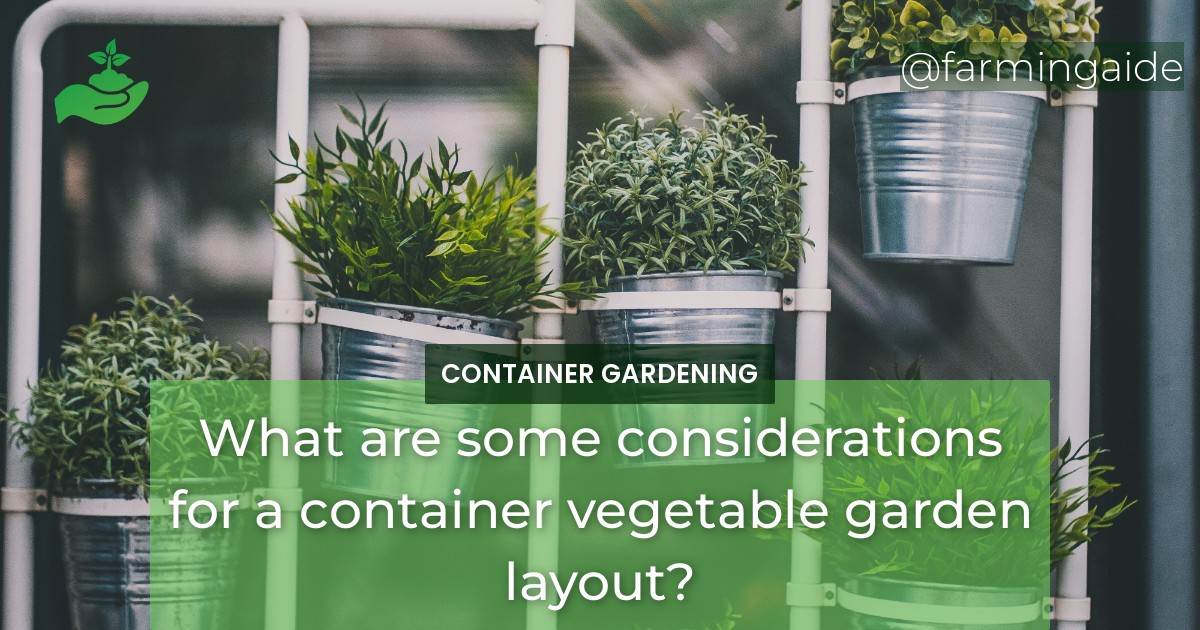Container gardening is an excellent way to grow fresh vegetables and herbs even in a limited space. An efficient layout is crucial when designing a container vegetable garden to maximize the yield and optimize the growth of the plants. The layout plan should cater to the specific needs of each vegetable and utilize the available space in the most efficient way possible.
Importance of designing an efficient layout for a vegetable container garden
Designing a container vegetable garden layout is essential for the following reasons:
- To optimize the use of space
- To ensure adequate sunlight and water supply for the plants
- To enhance the aesthetic appeal of the garden
- To simplify maintenance and harvesting of the vegetables
Factors to consider before designing a container vegetable garden layout
Size and shape of the container
The size and shape of the container determine the number and type of plants that can be grown. Large containers provide ample space for plants with extensive root systems, while smaller containers are suitable for shallow-rooted plants. The shape of the container can be rectangular, square, circular, or even irregular, depending on the available space and aesthetic preference.
Type of vegetable to be grown
The type of vegetable determines the size of the container, sunlight and water requirements, and the planting depth. Some vegetables like tomatoes, cucumbers, and peppers require larger containers, while others like lettuce and spinach do well in shallow containers.
Sunlight and temperature requirements
Most vegetables require at least 6 hours of direct sunlight per day. However, some vegetables like lettuce and spinach can tolerate partial shade. Additionally, some vegetables like peppers and tomatoes prefer warm temperatures, while others like broccoli and cauliflower thrive in cooler temperatures.
Water and drainage requirements
Containers should have adequate drainage holes to prevent waterlogging and root rot. Additionally, the container size and type of soil determine the frequency and amount of watering required. Vegetables grown in clay pots require more frequent watering than those grown in plastic containers.
Soil and fertilizer requirements
Choosing the right soil mixture is crucial for the growth and development of plants. Container soil should be well-draining and nutrient-rich. Additionally, adding organic fertilizer or compost can improve soil quality and provide essential nutrients for the plants.
Companion planting
Companion planting involves growing vegetables that have mutual benefits when planted together. For instance, planting basil with tomatoes can improve the flavor of the tomatoes and repel pests.
ALSO READ
Tips for designing an efficient layout for a container vegetable garden
Use of Vertical Space
Vertical gardening involves growing plants on trellises, fences, or stakes to save space and provide support for vining plants like peas and beans.
Grouping Vegetables According to Requirements
Group vegetables with similar water and sunlight requirements to simplify maintenance and watering.
Using Companion Planting Techniques
Companion planting is an excellent way to maximize the yield and enhance the flavor of the vegetables.
Crop Rotation in a Container Vegetable Garden
Rotate crops to prevent soil-borne diseases and pests and ensure the soil remains fertile.
Choosing the Right Container Size
Choose a container size that provides ample space for the vegetables to grow and allows for proper drainage.
Using Trellises and Stakes for Support
Trellises and stakes provide support for vining plants and ensure they grow vertically, saving space and simplifying harvesting.
What layout considerations should I keep in mind when creating a container vegetable garden?
When creating a vegetable container garden, consider the placement of containers to maximize sunlight and airflow. Choose large enough containers for root growth and ensure proper drainage. Group plants with similar watering needs. Opt for vertical and hanging options to save space. Select a fertile, well-draining potting mix.
Conclusion
In conclusion, designing an efficient layout for a container vegetable garden is crucial to maximize the yield, enhance the flavor of the vegetables, and optimize space. Consider the container size and shape, type of vegetable, sunlight and temperature requirements, water and drainage requirements, soil and fertilizer requirements, and companion planting techniques when designing the layout. Follow the tips provided to create a bountiful container vegetable garden and enjoy fresh, home-grown produce throughout the season!
RELATED ARTICLES:


